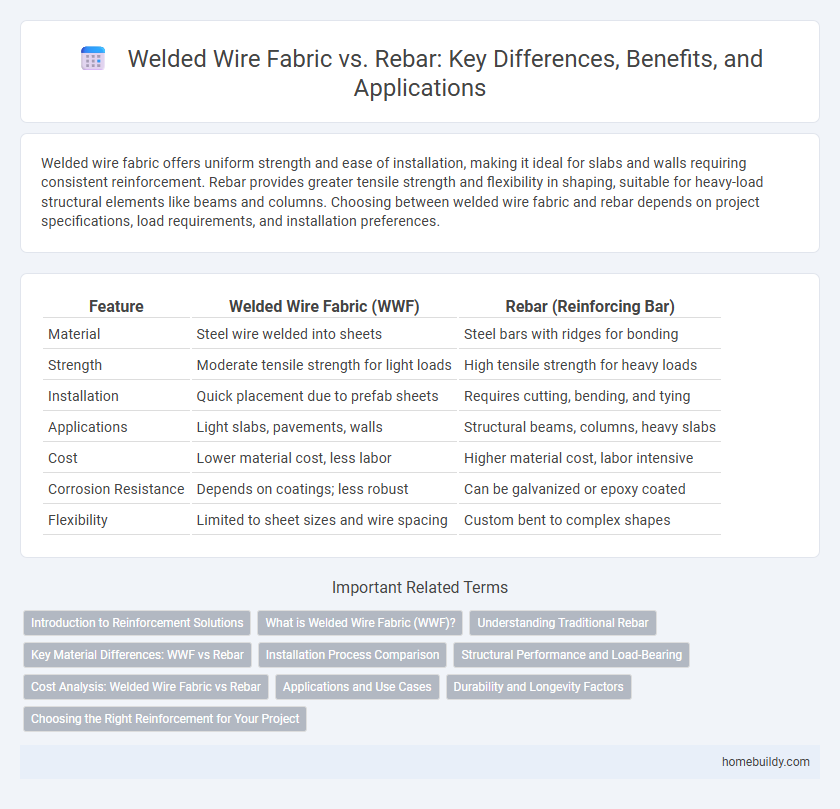Welded wire fabric offers uniform strength and ease of installation, making it ideal for slabs and walls requiring consistent reinforcement. Rebar provides greater tensile strength and flexibility in shaping, suitable for heavy-load structural elements like beams and columns. Choosing between welded wire fabric and rebar depends on project specifications, load requirements, and installation preferences.
Table of Comparison
| Feature | Welded Wire Fabric (WWF) | Rebar (Reinforcing Bar) |
|---|---|---|
| Material | Steel wire welded into sheets | Steel bars with ridges for bonding |
| Strength | Moderate tensile strength for light loads | High tensile strength for heavy loads |
| Installation | Quick placement due to prefab sheets | Requires cutting, bending, and tying |
| Applications | Light slabs, pavements, walls | Structural beams, columns, heavy slabs |
| Cost | Lower material cost, less labor | Higher material cost, labor intensive |
| Corrosion Resistance | Depends on coatings; less robust | Can be galvanized or epoxy coated |
| Flexibility | Limited to sheet sizes and wire spacing | Custom bent to complex shapes |
Introduction to Reinforcement Solutions
Welded wire fabric consists of a grid of steel wires welded at intersections, providing consistent spacing and ease of installation for concrete reinforcement. Rebar, or reinforcing bar, offers higher tensile strength and is commonly used in structural applications requiring significant load-bearing capacity. Both reinforcement solutions improve concrete durability and crack control but differ in application suitability based on project specifications.
What is Welded Wire Fabric (WWF)?
Welded Wire Fabric (WWF) consists of a grid of steel wires welded at intersections to form a reinforcement mesh used in concrete construction. It provides uniform strength distribution and crack control in slabs and walls, making it an efficient alternative to traditional rebar in specific applications. WWF is available in various mesh sizes and wire gauges to meet different structural requirements and enhance concrete durability.
Understanding Traditional Rebar
Traditional rebar, composed of steel bars with ridged surfaces, provides essential tensile strength and reinforcement in concrete structures. Unlike welded wire fabric, which consists of prefabricated grid panels of steel wire, rebar offers greater flexibility for bending and custom shaping on-site to meet specific structural requirements. Understanding the mechanical properties and applications of traditional rebar helps optimize concrete durability and load-bearing capacity in construction projects.
Key Material Differences: WWF vs Rebar
Welded Wire Fabric (WWF) consists of a grid of uniformly spaced, welded steel wires, providing consistent tensile strength and reducing crack widths in concrete slabs. Rebar, typically made from carbon steel with ridged surfaces, offers superior bond strength with concrete and higher load-bearing capacity in structural applications. Material differences influence application suitability, with WWF preferred for uniform stress distribution in slabs and rebar chosen for heavy-duty reinforcement in beams and columns.
Installation Process Comparison
Welded Wire Fabric offers quicker installation due to its prefabricated grid structure, reducing labor time compared to individual rebar placement. Rebar requires precise tying and positioning on-site, increasing installation complexity and time. The uniformity of welded wire fabric enhances consistency and speeds up reinforcement setup in concrete construction projects.
Structural Performance and Load-Bearing
Welded wire fabric (WWF) offers consistent spacing and ease of installation, enhancing crack control in concrete slabs, while rebar provides superior tensile strength and load-bearing capacity for heavy structural elements. Rebar's ability to handle higher stress levels makes it ideal for reinforcing beams, columns, and foundations that require significant structural performance under dynamic loads. Structural engineers often select rebar over welded wire fabric when maximum durability and load resilience are critical for safety and longevity.
Cost Analysis: Welded Wire Fabric vs Rebar
Welded Wire Fabric (WWF) generally offers lower installation labor costs compared to traditional rebar due to its prefabricated grid design, which reduces onsite welding and tying time. While WWF material costs can be slightly higher per unit area, the overall project expenses often decrease because of faster placement and minimized labor requirements. Rebar provides better adaptability for complex shapes but involves higher labor intensity and longer installation times, increasing total costs in large-scale concrete reinforcement projects.
Applications and Use Cases
Welded Wire Fabric (WWF) is commonly utilized in slab-on-grade applications, such as sidewalks, driveways, and flooring, due to its uniform grid pattern that provides consistent concrete reinforcement. Rebar offers superior tensile strength and flexibility, making it ideal for heavy-duty structural elements like beams, columns, and foundations in commercial and residential construction. Both materials enhance concrete durability but are chosen based on load requirements and specific structural demands.
Durability and Longevity Factors
Welded wire fabric offers uniform strength and consistent spacing, enhancing concrete durability by minimizing crack widths, while rebar provides superior tensile strength and better resistance to dynamic loads, contributing to longer structural lifespan. The corrosion resistance of rebar can be improved with epoxy coating or stainless steel options, whereas welded wire fabric typically requires proper concrete cover to prevent rusting and maintain longevity. Choosing between welded wire fabric and rebar depends on specific project requirements for strength, corrosion protection, and anticipated structural stresses affecting durability over time.
Choosing the Right Reinforcement for Your Project
Welded wire fabric offers uniform tensile strength and faster installation, making it ideal for slab or flatwork projects requiring consistent load distribution. Rebar provides superior tensile strength and flexibility, suitable for structural elements like beams, columns, and foundations requiring high load-bearing capacity. Selecting the right reinforcement depends on project specifications, load requirements, and installation efficiency to ensure optimal structural integrity.
Welded Wire Fabric vs Rebar Infographic

 homebuildy.com
homebuildy.com